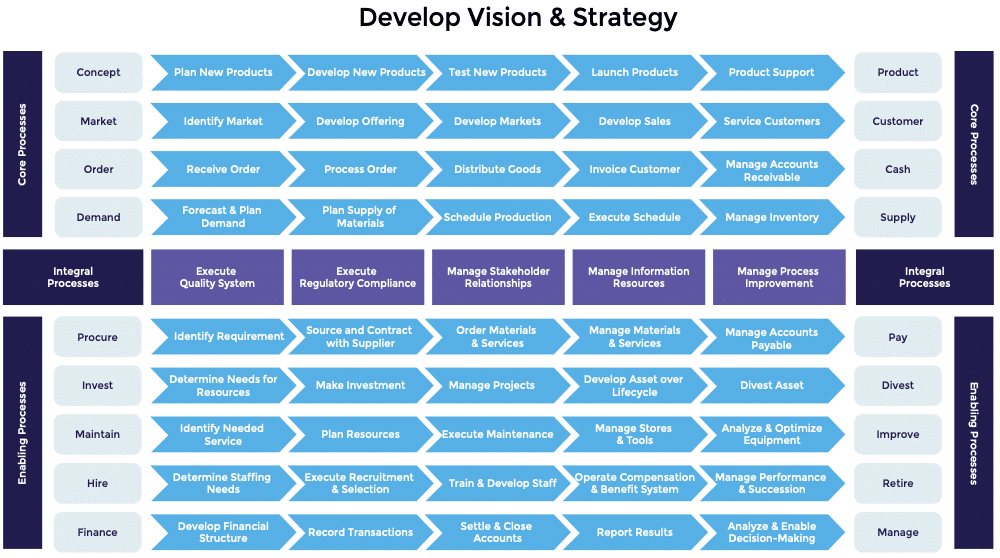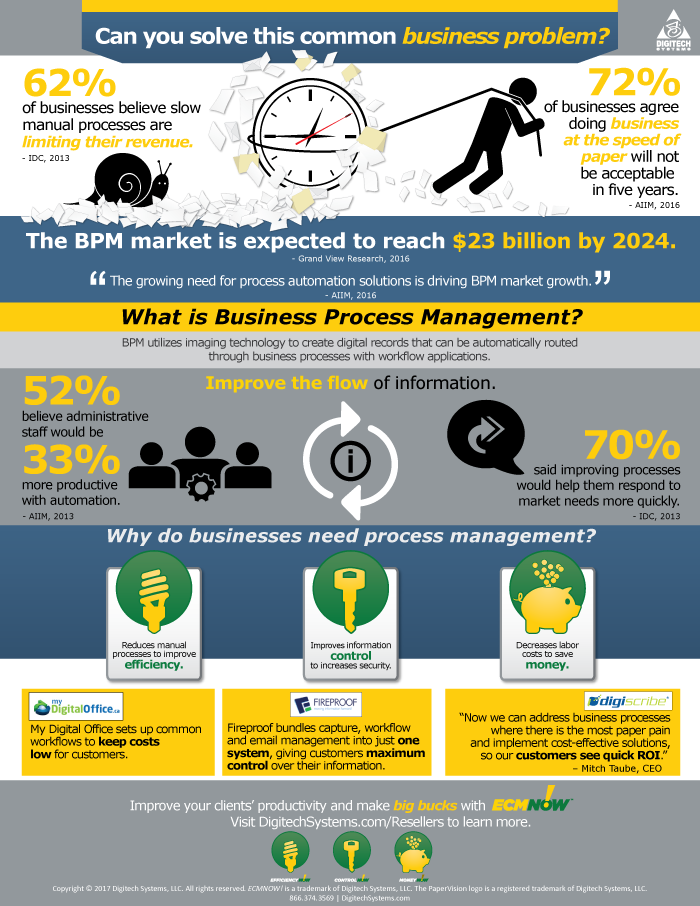Discover how implementing Enterprise Content Management can revolutionize your business operations, boost efficiency, and simplify your workflow.

Image courtesy of via DALL-E 3
Table of Contents
Introduction to Enterprise Content Management
Enterprise Content Management, often abbreviated as ECM, is a crucial tool for businesses looking to streamline their operations and optimize their workflows. In simple terms, ECM involves the organization, storage, and distribution of digital and physical content within an organization. It is all about managing the information and documents that a company generates and receives in its day-to-day operations.
What is Enterprise Content Management?
Enterprise Content Management, or ECM, is like a digital filing cabinet for businesses. It helps companies keep track of all their important documents and information in one central location. With ECM, employees can easily access the files they need, collaborate with their team members, and ensure that information is stored securely and efficiently.
Why Businesses Need ECM
Businesses benefit greatly from using ECM in several ways. Firstly, ECM improves efficiency by making it easier to find and share information. It also enhances productivity by streamlining processes and reducing the time spent searching for documents. Additionally, ECM helps companies comply with regulations and ensures that sensitive information is kept secure.
Types of Content Managed by ECM
When it comes to Enterprise Content Management (ECM), there are various types of content that these systems can efficiently handle. Whether it’s documents, images, videos, or records, ECM plays a crucial role in organizing and managing these different content types seamlessly.
Documents
One of the primary functions of ECM is to manage documents effectively. This includes reports, memos, invoices, contracts, and any other text-based content that is essential for a business. ECM helps in digitizing these documents, making them easily searchable and retrievable when needed.
Images and Videos
Visual content like images and videos are also managed by ECM systems. Whether it’s product photographs, marketing videos, or training materials, ECM ensures that these assets are stored securely and can be accessed efficiently by authorized users.
Records
Records management is a critical aspect of ECM, especially for compliance and regulatory purposes. ECM systems help in storing and organizing important records and data, ensuring that they are retained for the necessary periods and can be retrieved quickly when required.
Core Components of ECM
Enterprise Content Management (ECM) comprises several core components that work together to efficiently manage and organize business content. These components play a crucial role in streamlining business processes and ensuring that information flows seamlessly throughout an organization.

Image courtesy of www.linkedin.com via Google Images
Capture
ECM systems are designed to capture information from various sources, including paper documents and digital files. Through scanning, optical character recognition (OCR), and data extraction techniques, ECM software converts physical documents into digital formats, making them easily searchable and accessible.
Manage
Once information is captured, ECM helps organize and manage content effectively. This involves categorizing documents, creating metadata tags for easy retrieval, and establishing workflows for document approval and review processes. By centralizing content management, ECM simplifies collaboration and improves efficiency within the organization.
Store
ECM systems store and archive content securely, ensuring that data is safe from unauthorized access or loss. By employing encryption, access control mechanisms, and disaster recovery solutions, ECM safeguards valuable business information and minimizes the risk of data breaches or data loss.
Preserve
Preservation is a vital component of ECM, ensuring that information remains accurate, authentic, and accessible over time. ECM solutions include features such as version control, audit trails, and retention policies to manage the lifecycle of content and comply with legal and regulatory requirements.
Deliver
ECM facilitates the distribution of content to the right people at the right time. Through features like document sharing, access permissions, and content delivery workflows, ECM ensures that employees, partners, and customers can access relevant information efficiently, enhancing collaboration and decision-making processes.
ECM Technologies and Tools
In the world of Enterprise Content Management (ECM), technology plays a crucial role in helping businesses streamline their processes and manage their content effectively. Let’s delve into the various technologies and tools that support ECM systems.
Software Solutions
ECM software solutions are at the heart of managing and organizing content within an organization. These software platforms provide a centralized hub for storing, accessing, and collaborating on documents, images, and other essential data. By utilizing ECM software, businesses can enhance their productivity and efficiency while maintaining compliance with regulatory requirements.
Cloud-based ECM
Cloud-based ECM offers businesses the flexibility and scalability they need to store and access their content securely from anywhere, at any time. By leveraging the power of the cloud, organizations can improve collaboration among employees, enhance data security, and reduce the costs associated with traditional on-premise solutions.
AI and Automation
The integration of Artificial Intelligence (AI) and automation within ECM systems has revolutionized how businesses manage their content. AI-powered tools can intelligently classify and tag documents, automate workflows, and provide valuable insights into content usage. This not only saves time and reduces manual errors but also enables companies to make informed decisions based on data-driven analytics.
Implementing ECM in a Business
Implementing Enterprise Content Management (ECM) in a business can revolutionize how content is managed, organized, and accessed. By following the right steps and strategies, businesses can streamline their processes and enhance productivity. Let’s dive into how companies can start implementing ECM effectively.
Planning and Strategy
Before diving into implementing ECM, businesses need to create a thorough plan and strategy. This involves defining the goals and objectives of implementing ECM, conducting a content audit to understand the current state of content, and identifying key stakeholders who will be involved in the process.
Choosing the Right ECM
One of the crucial steps in implementing ECM is selecting the right ECM solution for your business. It’s essential to consider factors such as the size and nature of your organization, the specific needs of your industry, and the scalability of the ECM solution. A thorough evaluation of different ECM providers and their offerings is essential to make an informed decision.
Training and Adoption
Once the ECM system is selected, businesses need to focus on training employees to ensure a smooth adoption of the new system. Providing comprehensive training on how to use the ECM system, its features, and benefits is crucial. Additionally, creating a support system to address any questions or issues that arise during the adoption phase can help employees feel comfortable with the new system.
Advantages of Using ECM
One of the key advantages of using Enterprise Content Management (ECM) is the significant boost in efficiency it provides for businesses. ECM streamlines workflows, automates repetitive tasks, and ensures that employees have easy access to the information they need to do their jobs effectively. This results in faster decision-making and streamlined processes throughout the organization.

Image courtesy of sytecg.com via Google Images
Improved Productivity
ECM enhances productivity by enabling employees to focus on value-adding tasks rather than getting bogged down in managing and searching for information. With ECM tools, employees can quickly find the documents and data they need, collaborate seamlessly with team members, and stay organized. This leads to increased productivity and overall effectiveness in the workplace.
Compliance
Another significant advantage of using ECM is its ability to help businesses meet regulatory requirements and industry standards. ECM systems ensure that data is managed securely, retained for the required periods, and disposed of properly when needed. This helps companies avoid legal pitfalls and maintain compliance with various regulations, safeguarding their reputation and minimizing risks.
Enhanced Security
Security is a top priority for businesses in the digital age, and ECM offers robust security features to protect sensitive information. ECM systems use encryption, access controls, audit trails, and other security measures to safeguard data from unauthorized access, breaches, or data loss. By implementing ECM, companies can boost their data security and protect their valuable assets.
Challenges in ECM
Enterprise Content Management (ECM) comes with its own set of challenges that businesses need to navigate. Let’s explore some common obstacles faced when implementing ECM systems.
Cost
One significant challenge businesses encounter when adopting ECM is the financial investment required. Purchasing ECM software, setting up the infrastructure, and training employees can incur substantial costs. Companies need to carefully weigh the benefits of ECM against its implementation expenses to ensure a positive return on investment.
Training Staff
Another hurdle companies face is the challenge of training employees to effectively use ECM systems. Transitioning from traditional document management methods to a digital ECM platform can be daunting for staff members who are accustomed to manual processes. Providing thorough training and resources is crucial to ensure a smooth integration and maximize the benefits of ECM.
Integration with Existing Systems
Integrating ECM with existing systems and tools within a business can be a complex task. Compatibility issues, data migration, and ensuring seamless communication between different platforms are common obstacles that organizations must tackle. Smooth integration is key to leveraging the full potential of ECM and enhancing overall efficiency.
Future of ECM
As technology continues to advance at a rapid pace, the future of Enterprise Content Management (ECM) holds exciting possibilities. Let’s look at some emerging trends and the potential role of Artificial Intelligence (AI) in shaping the landscape of ECM.

Image courtesy of www.digitechsystems.com via Google Images
Emerging Trends
One of the key emerging trends in ECM is the shift towards more seamless and intuitive user experiences. ECM systems are evolving to be more user-friendly and accessible, making it easier for employees to interact with and leverage the system efficiently.
Another trend to watch is the increasing integration of ECM with other business systems. This integration allows for a smoother flow of information across different platforms, enhancing overall productivity and collaboration within organizations.
Furthermore, the rise of mobile ECM solutions is gaining traction. Mobile access to ECM platforms enables employees to work remotely and stay connected to critical business content, enhancing flexibility and efficiency.
Role of AI in ECM
Artificial Intelligence is poised to revolutionize the field of ECM. AI capabilities are being integrated into ECM systems to automate routine tasks, improve search functionality, and enhance content classification and organization.
By harnessing AI algorithms, ECM systems can analyze vast amounts of data, extract valuable insights, and provide predictive analytics to support better decision-making processes within businesses. This automation and intelligence augmentation promise to streamline workflows, reduce manual labor, and increase operational efficiency.
With AI playing a significant role in ECM, businesses can expect smarter content management solutions that adapt to their needs, anticipate challenges, and drive innovation in how information is captured, managed, stored, preserved, and delivered.
Conclusion and Summary
In wrapping up our discussion on Enterprise Content Management (ECM), it’s crucial to revisit the key points we’ve covered throughout this blog. ECM plays a vital role in modern businesses by effectively managing various types of content to streamline processes and enhance efficiency. Let’s summarize the main takeaways from our exploration:
Key Takeaways
Introduction to Enterprise Content Management: ECM is a system that helps businesses organize and control their content, improving workflow and productivity.
Types of Content Managed by ECM: ECM handles documents, images, videos, and records, ensuring all essential information is stored and accessible when needed.
Core Components of ECM: The capture, manage, store, preserve, and deliver functions of ECM work together to maintain content integrity and aid in efficient distribution.
ECM Technologies and Tools: Technologies like software, cloud storage, AI, and automation support ECM functions, making content management seamless and effective.
Implementing ECM in a Business: Planning, strategy, and proper training are essential for successful implementation of ECM within a business, ensuring optimal utilization.
Advantages of Using ECM: Increased efficiency, improved productivity, regulatory compliance, and enhanced security are some of the key benefits companies experience when utilizing ECM.
Challenges in ECM: Cost considerations, employee training, and integration with existing systems are common challenges that businesses may face when implementing ECM.
Future of ECM: As technology evolves, ECM will continue to see advancements in AI integration and other innovative trends that shape the future of content management.
Final Thoughts
In conclusion, ECM is a powerful tool for businesses seeking to optimize their content management processes. By investing in a robust ECM system and addressing challenges with strategic planning, businesses can unlock increased efficiency, productivity gains, and enhanced security. As technology continues to advance, embracing the future trends in ECM will be essential for staying ahead in the digital landscape. With a solid understanding of ECM and its benefits, businesses can transform the way they handle and distribute content, paving the way for success in the modern business world.
Want to turn these SEO insights into real results? Seorocket is an all-in-one AI SEO solution that uses the power of AI to analyze your competition and craft high-ranking content.
Seorocket offers a suite of powerful tools, including a Keyword Researcher to find the most profitable keywords, an AI Writer to generate unique and Google-friendly content, and an Automatic Publisher to schedule and publish your content directly to your website. Plus, you’ll get real-time performance tracking so you can see exactly what’s working and make adjustments as needed.
Stop just reading about SEO – take action with Seorocket and skyrocket your search rankings today. Sign up for a free trial and see the difference Seorocket can make for your website!
Frequently Asked Questions (FAQs)
What is ECM?
Enterprise Content Management (ECM) is a system that helps businesses manage their documents, records, images, and other important content in a structured and efficient manner. It allows organizations to capture, store, manage, preserve, and deliver content to the right people at the right time.
How does ECM benefit a business?
ECM offers several advantages to businesses, including increased efficiency, improved productivity, better compliance with regulations, and enhanced security for sensitive information. By streamlining business processes and centralizing content management, ECM helps companies work more effectively and make better-informed decisions.
What are the challenges of ECM?
While ECM can bring significant benefits to businesses, there are some common challenges that organizations may face when implementing ECM. These challenges can include the initial cost of setting up an ECM system, training staff to use it effectively, and integrating the ECM system with existing tools and processes.







